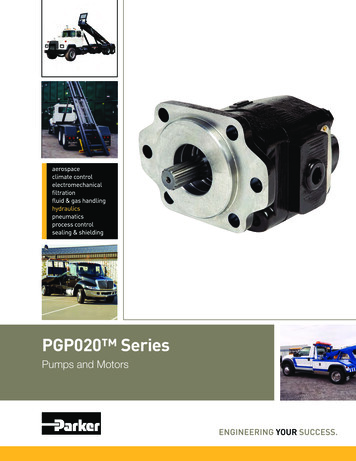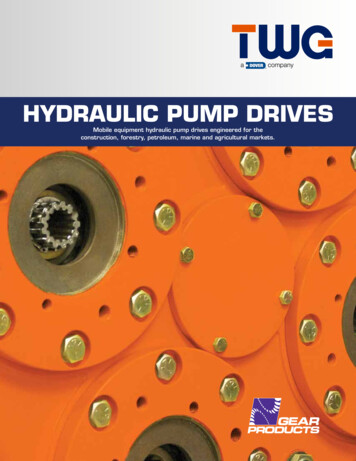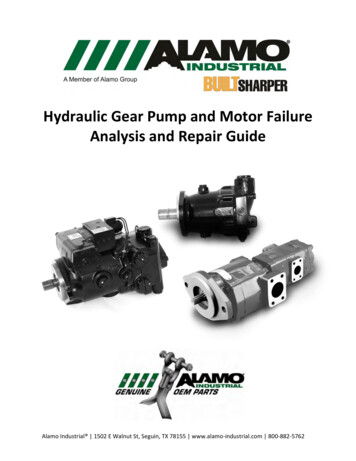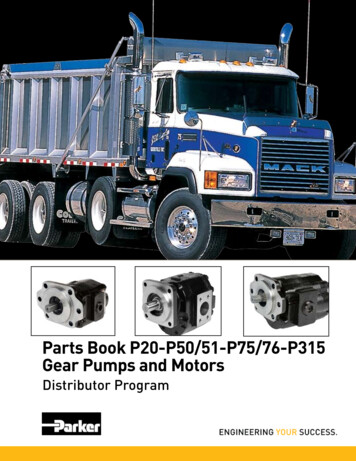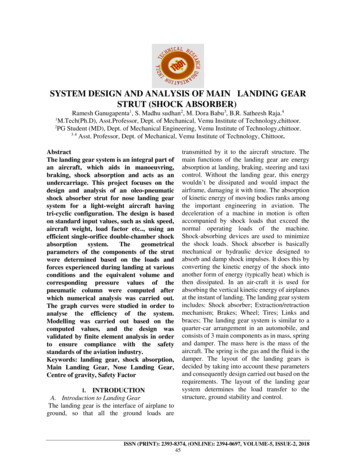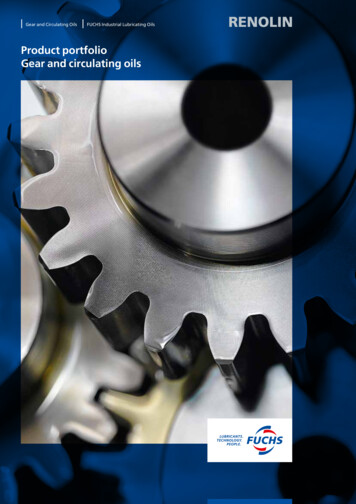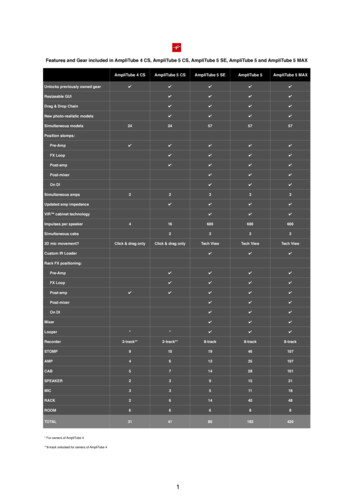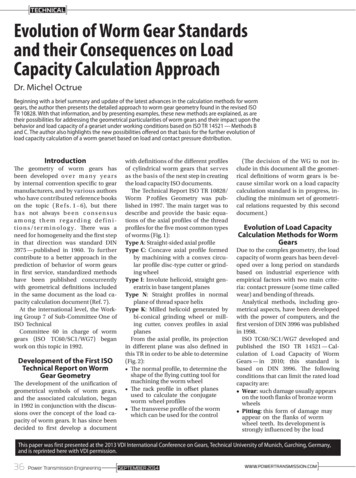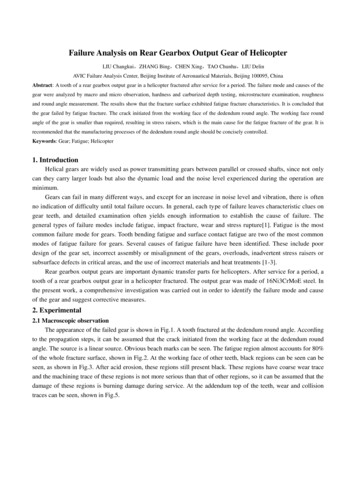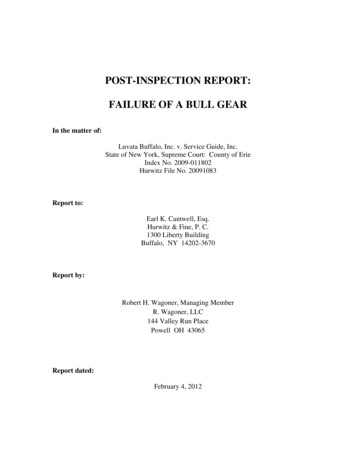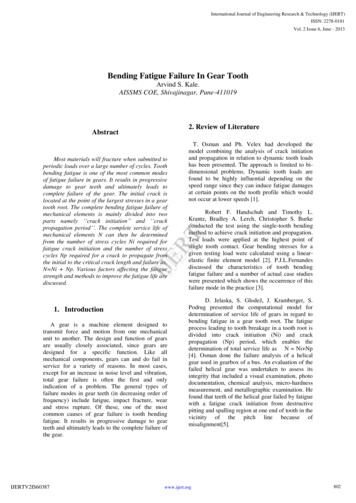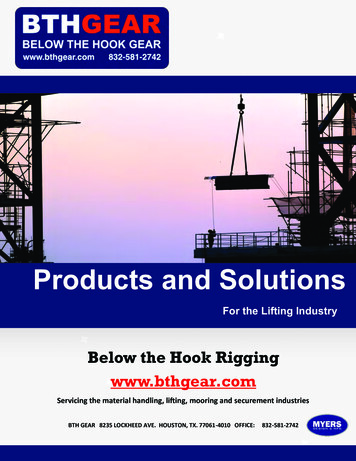
Transcription
Products and SolutionsFor the Lifting IndustryBelow the Hook Riggingwww.bthgear.comServicing the material handling, lifting, mooring and securement industriesBTH GEAR 8235 LOCKHEED AVE. HOUSTON, TX. 77061-4010 OFFICE:832-581-2742
BTHGEARBELOW THE HOOK GEARwww.bthgear.com832-581-2742GeneralPRODUCTS AND SOLUTIONSServices Design, Engineering andFabrication Full Welding Services Testing and recertifications Proof Testing NDE/NDT Inspections Machining Custom Fabrication Jib CraneGantry CraneTurnerUpenderCrane MatsPipe StandsLoad Rated Crane MatsMono RailsLoad Rated Support BeamsLoad Rated Stands and CansLifting Beams Load TestingStandardAdjustableChannelAdjustable ChannelPlateTriangle PlateH BarT BarX Bar Spreader Beams StandardCollector/Spreader RingAdjustable Swiveling LugEnd Cap SystemSliding LugTelescoping LugModularSlingsCranes & Lifting EquipmentTesting and GrippingPadeye Test MachineE4 Load Cells & CalibrationsSoftwareIndicatorsMYERS DESIGN & MFGProof Testing MachinesPortable Pad Eye TestersGround anchor testing unitsLoad Cells for the Lab and the FieldCustom Load CellsSales & Rentals from1000 lbs. to 12,000,000 lbsBaskets & Storage Personnel BasketsSkip PanMaterialStationary and Portable RiggingStoragewww.bthgear.com Synthetic Round SlingsHigh Performance Round SlingsHigh Performance RopesChain SlingsWire Rope SlingsMaterial Handling Coil LifterPallet LifterBulk Bag LifterForklift BoomsForklift ExtensionsRigging Hardware Equalizing BlocksPad Eyes / LugsClevis and CouplingsD-ringsSwivel Hoist RingsShacklesLinksHooksTag LinesChafe Guards Concrete HandlingPipe CarrierLow Profile Pipe CarrierPipe PickerC-Hook Pipe LifterHousing Lifteri
BTHGEARBELOW THE HOOK gn & Engineering Licensed Engineer Mechanical system design and structural analysis Below the hook lifting equipment design Rigging engineering and lift planning Bearing experience for crane installations Lifting gear and crane inspections Load testing and training FAA part 107 drone operations Aerial inspection and mapping utilizing Matrice 210, inspire 2and Phantom 4 pro ASME B30.32 subcommittee member, “UAS” used in theinspecting, testing, maintenance and load handlingoperations” Software working knowledge Solidworks 2019, SolidworksFEA simulation, Inventor 2019, Mathcad 15, Autocad andMicrosoft Office productswww.bthgear.comii
BTHGEARBELOW THE HOOK facturing Lifting products engineered and manufacturedper ASME BTH-1 Lifting products are labeled, tested, anddocumented per ASME B30.20 and OSHA Structural products manufactured per AISC API manufacturing available Welding per AWS D1.1 and D14.1Testing & Inspection Services Safety and Performance InspectionsProof TestingIn-house NDT TestingQuality System Review of customer design requirements to ensure the best solution and equipment is providedDrawings provided for customer approval and recordsDNV and ISO compliant record keepingIn-process Inspections and Hold points ensure material specifications, dimensional requirements, process, andtesting requirements are metProof Testing performed in accordance with industry standardsData Packages provided for all equipment include final drawings, MTR’s, test reports and certifications whereapplicableCertificates and documents available onlineCertified welders and welding equipmentwww.bthgear.comiii
BTHGEARBELOW THE HOOK GEARwww.bthgear.com832-581-2742GENERALSAFETY RECOMMENDATIONSSafety Guidelines Contact the proper personnel for use of a lifting deviceContact the lifting device mfg. or other qualified personsfor any operational concernsInspect the lifting device prior to every useConfirm any attached rigging is correct for the lifting device.Never exceed: RC-Rated Capacity WLL- Working Load Limit, SWL- Safe Working Load of the lifting deviceNever cut, weld, or modify any lifting deviceBe aware of pinch points during handlingEnsure operator is properly trained in operating the lifting deviceUnderstand the manufacturer’s instructions and warningsStay clear of all lifted loadsNever stand or travel below a lifted loadRemove lifting device immediately from service if the metal tag isdamaged, ineligible, or missingThe load rating is not knownThe lifting device has been overloaded, damaged, or modifiedEquipment DataManufacture:BTH GEARDate of Manufacture:Serial Number:Device Weight:ASME BTH‐1 Design CategoryCategory A ‐ Design Factor of 2:1Category B ‐ Design Factor of 3:1Category C ‐ Design Factor of 6:1Location:Houston, TexasCountry:United StatesLoad Rating:ASME BTH‐1 Service ClassClassLoad Cycles0 0‐20,0001 20,001 ‐ 100,0002 100,001 ‐ 500,0003 500,001 ‐ 2,000,0004 Over 2,000,000Safety Tags Per ASME all bellow the hook lifting gear must be incompliance for use. Remove from service if the device: Does not have a tag with the “tag requirements”clearly visible The device has been overloaded The device has been modifiedInstallation:All lifting equipment shall be assembled and installed in accordance with themanufacture's instructions.WARNING & SAFETY INSTRUCTIONS‐ CONTACT THE PROPER PERSONNEL FOR THE USE OF THIS DEVICE‐ NEVER EXCEED THE “WLL” WORKING LOAD LIMIT OF THIS DEVICE‐ CONFIRM PROPER SAFETY PROTOCOLS / GEAR IS IN PLACE‐ CONFIRM ATTACHED RIGGING IS ADEQUATE FOR THIS DEVICE‐ INSPECT THIS DEVICE VISUALLY BEFORE EVERY USE‐ CONTACT PROPER PERSONNEL WITH OPERATIONAL CONCERNS‐ NEVER CUT, MODIFY, OR WELD, THIS DEVICEIMPROPER USE OF THIS DEVICE COULD RESULT IN INJURYQuestions or concerns contact 281‐728‐7321 or info@myersdnm.comwww.bthgear.comMDWSI2018iv
BTHGEARBELOW THE HOOK GEARwww.bthgear.com832-581-2742GENERALSAFETY RECOMMENDATIONSOSHA RequirementsRiggers must be: Trained to understand and recognize the hazards associated with theassigned task. Qualified to do assigned work and comply with proper procedures. Aware of the surface conditions upon which a crane is operating. The surface should be level within 1% grade and firm enough tosupport the crane and load. Examine where the load will be set. Remove unnecessary blocks,equipment or other materials that can injure workers if struck by theload. Familiar with the various and correct rigging techniques and riggingequipment (e.g., slings, shackles, hooks, hoist, blocks). Able to anticipate problems before they occur. Stop the job when any potentially unsafe conditions are present. Aware of the weight of the load and understand the rated capacities ofthe crane and any rigging gear (1915.111(b)).Equipment: All rigging gear and equipment provided by the employer must beinspected before each shift and at intervals during its use to minimizethe possibility of a rigging failure (1915.111(a)). Overloading the crane and rigging gear may cause: The crane hoist line to part or the rigging gear to fail. The crane to tip over. Damage to and possible failure of the crane. Defective gear and equipment must be immediately removed fromservice (1915.111(a)). Check nylon slings for cuts or frayed areas. Manila rope slings should be checked to determine that theyare safe for the intended working loads (1915.112(a)(1)). Check wire rope slings for kinks or broken wires or strands. Check chain slings for stretched links (1915.112(c)(2)). Check hooks to make sure they are not bent from overloading.Slings or Ropes: Check that the crane hook safety latch automatically retracts to Slings must not be used over sharp corners without paddingthe closed position upon release.(1915.116(f)). Bent or sprung hooks must not be used (1915.113(b)(3)). Slings must not be covered with permanent padding that would prevent See hem from being inspected before each use.fiber.html Use softeners, padding, chaffing gear or other sling protection asnecessary to prevent damage to nylon slings. Kinked or knotted wire rope slings should be removed from servicePad Eyes:(1915.111). Wire rope shall not be secured by knots (1915.112(b)(4)). Pad eyes should be designed for a specific use. Each pad eye should be able to hold the intended weight/force thatLifting:will be applied to it after it is welded into place. Avoid lifts near stacked material that may be knocked over by Inspect pad eyes for cracks and other defects that will affect itsa swinging load (1915.116(k)).capacity. Always check for overhead power lines before lifting a load. Remove defective pad eyes from the work area. Before loads or empty lifting gear are raised, lowered, or All pad eyes should be welded solidly all around. Weld the middleswung, advance warning must be given to workers operating inof the pad eye on both sides first, then weld both ends.the vicinity (1915.116(p)). Inspect fitting tools and equipment such as come-alongs, chain Use a designated spotter to assure that proper clearances arefalls, turnbuckles, chains and hook ratchets that will be used withmaintained.pad eyes. A worker or signalman who is familiar with signal codes must Make sure that the hooks from the come-alongs and chain falls arecommunicate with the crane operator (1915.116(l)).seated properly in the eye of the pad eye. When walking with a load, keep it as close to the ground as Do not overstress the fitting tools – use up to 80% of their capacity.possible. When applying pressure with fitting tools or equipment to pad Inspect the spot where the load is to be landed.eyes, make sure that everyone is well out of the danger zone in the When lowering or setting a load, set it down slowly.event that the pad eye tears off the surface it was welded to. Tag lines must be provided on loads likely to swing or needguidance (1915.116(d)). Do not use tag lines to control lift when the lift is under ornear electrical power lines. Riggers must not place themselves in a hazardous positionbetween a swinging load and a fixed object (1915.116(q)). Workers are not to work under the load. Workers must not ride a load or hook (1915.116(i)). Riggers should keep fingers, hands and feet away frompinch points.www.bthgear.comv
BTHGEARBELOW THE HOOK GEARwww.bthgear.com832-581-2742GENERALHAND SIGNALS FOR CRANE OPERATIONwww.bthgear.comvi
BTHGEARBELOW THE HOOK GEARwww.bthgear.com832-581-2742GENERALTABLE OF CONTENTSGeneral .Products and Solutions. iServices . iiSafety Recommendations . ivHand Signals For Crane Operation . viTable of Contents . viiQuick Find Index . ixLifting Beams . 1A. Standard Lifting Beam.1-1C. Channel Lifting Beam.1-3D. Adjustable Lifting Beam .1-7E. Plate/Tilt Wall Lifting Beam .1-10SB. Super Beam .1-10F. Triangle Plate Lifting Beam .1-11G. H Bar Lifting Beam.1-13H. T Bar Lifting Beam .1-15Spreader Beams . 2J. Standard Spreader Beam .2-1K. Collector/Spreader Ring .2-5ASL. Adjustable Swiveling Lug Spreader Beam .2-6ECS. End Cap System Spreader Beam .2-7SL. Sliding Lug Spreader Beam .
per ASME BTH-1 Lifting products are labeled, tested, and documented per ASME B30.20 and OSHA Structural products manufactured per AISC API manufacturing available Welding per AWS D1.1 and D14.1 Testing & Inspection Services Safety and Performance Inspections Proof Testing In-house NDT Testing Quality System Review of customer design requirements to ensure the best solution and
